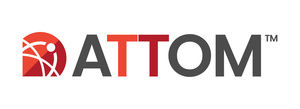Metro Areas More Exposed to Market Downturns Again Led by New York City and Chicago; South and Midwest Regions Still Face Relatively Low Expose to Declines
IRVINE, Calif., June 13, 2024 /PRNewswire/ -- ATTOM, a leading curator of land, property, and real estate data, today released a Special Housing Risk Report spotlighting county-level housing markets around the United States that are more or less vulnerable to declines, based on home affordability, underwater mortgages and other measures in the first quarter of 2024. The report shows that California, New Jersey and Illinois once again had the highest concentrations of the most-at-risk markets in the country, with some of the biggest clusters in the New York City and Chicago areas, as well as inland California. Less-vulnerable markets remained spread mainly throughout the South and Midwest.
The first-quarter patterns – derived from gaps in home affordability, underwater mortgages, foreclosures and unemployment - revealed that California, New Jersey and Illinois had 34 of the 50 counties around the U.S. considered most exposed to potential drop-offs. As with earlier periods over the past few years, those concentrations dominated the list of metropolitan areas more at risk of downturns.
The 50 counties on the list included six in and around Chicago, five in the New York City metropolitan area and 14 in areas of California mostly away from the Pacific coast. The rest were scattered around other parts of the country.
At the other end of the risk spectrum, 22 of the 50 markets considered least likely to decline fell in Virginia, Wisconsin and Tennessee. They included four each in the Washington, DC, and Richmond, VA, metro areas.
"The patterns of varying market vulnerability that we've been seeing over the past few years are pretty much continuing in place, with some of the same areas falling out at opposite ends of the trend line," said Rob Barber, CEO at ATTOM. "Once again, this is not to suggest that any one market is facing imminent decline. It's more a measure of vulnerability gaps. But with the housing market slowing down over the past year, some metro areas appear notably better positioned than others to withstand a scenario of the market topping out and heading downward."
Counties were considered more or less at risk based on the percentage of homes facing possible foreclosure, the portion with mortgage balances that exceeded estimated property values, the percentage of average local wages required to pay for major home ownership expenses on median-priced single-family homes and local unemployment rates. The conclusions were drawn from an analysis of the most recent home affordability, equity and foreclosure reports prepared by ATTOM. Unemployment rates came from federal government data. Rankings were based on a combination of those four categories in 590 counties around the United States with sufficient data to analyze in the first quarter of 2024. Counties were ranked in each category, from lowest to highest, with the overall conclusion based on a combination of the four ranks. See below for the full methodology.
Widely varying levels of risk continued to show up around throughout the country in the first quarter of 2024 following a year when various market metrics - including home prices, profits, equity and affordability – tracked lower or cooled off across much of the nation.
Chicago and New York City metro areas remain more vulnerable along with large areas of California
The metropolitan areas around Chicago, IL, and New York, NY, as well as broad stretches of northern and central California, had 25 of the 50 U.S. counties considered most vulnerable in the first quarter of 2024 to housing market troubles (from among 590 counties with enough data to analyze).
The 50 most at-risk counties included De Kalb, Kane, Kendall, McHenry and Will counties in Illinois and Lake County in Indiana, one in New York City (Kings County, which covers Brooklyn) and four in the New York City suburbs (Essex, Passaic, Sussex and Union counties, all in New Jersey).
The 14 in California included Butte County (Chico), El Dorado County (outside Sacramento), Humboldt County (Eureka), Solano County (outside Sacramento) and Yolo County (outside Sacramento) in the northern part of the state, and Fresno County, Kern County (Bakersfield), Kings County (outside Fresno), Madera County (outside Fresno), Merced County, San Joaquin County (Stockton), Stanislas County (Modesto) and Tulare County (outside Fresno) in central California. One other, San Bernardino County, was in southern California.
Counties facing greater exposure to declines have weaker levels of affordability, underwater mortgages, foreclosures and unemployment
Major home-ownership costs (mortgage payments, property taxes and insurance) on median-priced single-family homes and condos consumed more than one-third of average local wages in 36 of the 50 counties that were considered most vulnerable to market drop-offs in the first quarter of 2024. Nationwide, major expenses on typical homes sold in the first quarter required 32.3 percent of average local wages – almost exactly one-third.
The highest percentages in the 50 most at-risk markets were in Kings County (Brooklyn), NY (109.5 percent of average local wages needed for major ownership costs); El Dorado County, CA (outside Sacramento) (64 percent); Passaic County, NY (outside New York City) (62.1 percent); San Joaquin County (Stockton), CA (58.4 percent) and San Bernardino County, CA (57.3 percent).
At least 5 percent of residential mortgages were underwater in the first quarter of 2024 in 41 of the 50 most-at-risk counties. Nationwide, 6.6 percent of mortgages fell into that category, with homeowners owing more on their mortgages than the estimated value of their properties. Those with the highest underwater rates among the 50 most at-risk counties were Webb County (Laredo), TX (31.5 percent underwater); Tangipahoa Parish, LA (east of Baton Rouge) (21.2 percent); Livingston Parish, LA (20.6 percent); Peoria County, IL, (19.8 percent) and Hardin County, KY (outside Louisville) (15.9 percent).
More than one of every 1,000 residential properties faced a foreclosure action in the first quarter of 2024 in 44 of the 50 most vulnerable counties. Nationwide, one in 1,478 homes were in that position.
The highest foreclosure-case rates among the top 50 counties were in Osceola County (Kissimmee), FL (one in 480 residential properties facing possible foreclosure); Cumberland County (Vineland), NJ, (one in 488); Warren County, NJ (outside Allentown, PA) (one in 517); Sussex County, NJ (outside New York City) (one in 555) and Lake County, IN (outside Chicago, IL) (one in 567).
The March 2024 unemployment rate was at least 5 percent in 30 of the 50 most at-risk counties, while the nationwide figure stood at 3.8 percent. The highest rates in the top 50 counties were all in central California: Tulare County, CA (outside Fresno) (12 percent); Merced County, CA (11.6 percent); Kern County (Bakersfield), CA (10.2 percent); Kings County, CA (outside Fresno) (10.1 percent) and Fresno County, CA (9.2 percent).
Counties least at risk spread mostly throughout South and Midwest
Twenty-four of the 50 counties considered least vulnerable to housing-market problems from among the 590 included in the first-quarter report were in the South and 19 were in the Midwest. Just four were in the Northeast while three were in the West.
Virginia had nine of the 50 least at-risk counties in the first quarter: Alexandria City, Arlington, Fairfax and Loudoun counties, all in the Washington, DC, area, as well as Chesterfield, Hanover, Henrico and Richmond City counties in the Richmond, VA, area. Albemarle County (Charlottesville) also was on the bottom 50 list.
Another seven of the 50 least vulnerable counties were in Wisconsin. They were Brown County (Green Bay), Outagamie County (outside Green Bay), Dane County (Madison), Rock County (outside Madison), Eau Claire County, La Crosse County and Winnebago County (Oshkosh). Six more were in Tennessee. They included Davidson, Rutherford and Williamson counties in the Nashville metro area, Blount and Knox County in the Knoxville area and Sullivan County (Kingsport).
Less-vulnerable counties have better across-the-board market measures
Major ownership costs on median-priced single-family homes and condos required more than one-third of average local wages in 28 of the 50 counties that were considered least vulnerable to market problems in the first quarter of 2024 (compared to 36 of the most at-risk counties).
The highest levels were in Gallatin County (Bozeman), MT (64.9 percent of average local wages needed for major ownership costs); Williamson County, TN (outside Nashville) (58.8 percent); Loudoun County, VA (outside Washington, DC) (55.8 percent); Alexandria City/County, VA (52.2 percent) and Cumberland County (Portland), ME (49.4 percent).
Less than 5 percent of residential mortgages were underwater in the first quarter of 2024 (with owners owing more than their properties were worth) in 38 of the 50 least-at-risk counties. Those with the lowest rates were Chittenden County (Burlington), VT (0.9 percent underwater); Loudoun County, VA (outside Washington, DC) (1.9 percent); Hillsborough County (Manchester), NH (2 percent); Cumberland County (Portland) ME (2.2 percent) and Gallatin County (Bozeman), MT (2.6 percent).
More than one in 1,000 residential properties faced a foreclosure action during the first quarter of 2024 in none of the 50 least-at-risk counties. Those with the lowest rates were Eau Claire County, WI (one in 22,621 residential properties facing possible foreclosure); Chittenden County (Burlington), VT (one in 18,302); Dane County (Madison), WI (one in 15,651); Arlington County, VA (one in 13,250) and Winnebago County (Oshkosh), WI (one in 10,910).
The March 2024 unemployment rate was less than 4 percent in all 50 of the least-at-risk counties. The lowest rates among those counties were in Chittenden County (Burlington), VT (1.4 percent); Arlington County, VA (1.8 percent); Alexandria City/County, VA (2.1 percent); Hanover County (Richmond), VA (2.1 percent) and Fairfax County, VA (outside Washington, DC) (2.1 percent).
Report methodology
The ATTOM Special Market Impact Report is based on ATTOM's first-quarter 2024 residential foreclosure, home affordability and underwater property reports, plus March 2024 unemployment figures from the U.S. Bureau of Labor Statistics. (Press releases for affordability, foreclosure and underwater-property reports show the methodology for each.) Counties with sufficient data to analyze were ranked based on the first-quarter percentage of residential properties with a foreclosure filing, the percentage of average local wages needed to afford the major expenses of owning a median-priced home and the percentage of properties with outstanding mortgage balances that exceeded their estimated market values, along with March 2024 county-level unemployment rates. Ranks then were added up to develop a composite ranking across all four categories. Equal weight was given to each category. Counties with the lowest composite rank were considered most vulnerable to housing market problems. Those with the highest composite rank were considered least vulnerable.
About ATTOM
ATTOM provides premium property data to power products that improve transparency, innovation, efficiency, and disruption in a data-driven economy. ATTOM multi-sources property tax, deed, mortgage, foreclosure, environmental risk, natural hazard, and neighborhood data for more than 155 million U.S. residential and commercial properties covering 99 percent of the nation's population. A rigorous data management process involving more than 20 steps validates, standardizes, and enhances the real estate data collected by ATTOM, assigning each property record with a persistent, unique ID — the ATTOM ID. The 30TB ATTOM Data Warehouse fuels innovation in many industries including mortgage, real estate, insurance, marketing, government and more through flexible data delivery solutions that include ATTOM Cloud, bulk file licenses, property data APIs, real estate market trends, property navigator and more. Also, introducing our newest innovative solution, making property data more readily accessible and optimized for AI applications– AI-Ready Solutions.
Media Contact:
Megan Hunt
[email protected]
Data and Report Licensing:
[email protected]
SOURCE ATTOM

WANT YOUR COMPANY'S NEWS FEATURED ON PRNEWSWIRE.COM?
Newsrooms &
Influencers
Digital Media
Outlets
Journalists
Opted In





Share this article